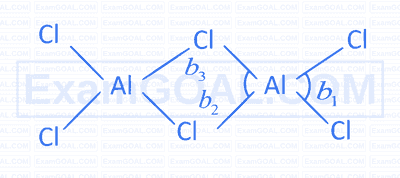Chemical Bonding and Molecular Structure · Chemistry · AP EAPCET
MCQ (Single Correct Answer)
Which of the following sets are correctly matched?
(i) $\mathrm{B}_2 \mathrm{H}_6$ - electron deficient hydride
(ii) $\mathrm{NH}_3$ - electron precise hydride
(iii) $\mathrm{H}_2 \mathrm{O}$ - electron rich hydride
Which of the following is /are ionic in nature?
(i) $\mathrm{GeF}_4$
(ii) $\mathrm{SnF}_4$
(iii) $\mathrm{PbF}_4$
The correct option is

$$ \text { In the given structure of diborane } \theta_1, \theta_2 \text { are respectively } $$

Which of the following orders are correct regarding their covalent character?
(i) $\mathrm{KF}<\mathrm{KI}$
(ii) $\mathrm{LiF}<\mathrm{KF}$
(iii) $\mathrm{SnCl}_2<\mathrm{SnCl}_4$
(iv) $\mathrm{NaCl}<\mathrm{CuCl}$
The correct option is
$$ \text { Observe the following sets. } $$
$$ \begin{array}{lll} \hline \text { Order } & \text { Property } \\ \hline \text { (i) } \mathrm{NH}_3>\mathrm{H}_2 \mathrm{O}>\mathrm{SO}_2 & \text { Bond angle } \\ \hline \text { (ii) } \mathrm{H}_2 \mathrm{O}>\mathrm{NH}_3>\mathrm{H}_2 \mathrm{~S} & \text { Dipole moment } \\ \text { (iii) } \mathrm{N}_2>\mathrm{O}_2>\mathrm{H}_2 & \text { Bond enthalpy } \\ \hline \text { (iv) } \mathrm{NO}^{+}>\mathrm{O}_2>\mathrm{O}_2^{2-} & \text { Bond order } \\ \hline \end{array} $$
$$ \text { Observe the following structure, } $$

$$ \text { The formal charges on the atoms 1,2,3 respectively are } $$

| List - I (Bond ) | List - II (Bond enthalpy (in $\mathrm{kJ} \mathrm{mol}^{-1}$ ) |
| A $\mathrm{Si}-\mathrm{Si}$ | I 240 |
| B $\mathrm{C}-\mathrm{C}$ | II 297 |
| C $\mathrm{Sn}-\mathrm{Sn}$ | III 348 |
| D $\mathrm{Ge}-\mathrm{Ge}$ | IV 248 |
In the Lewis dot structure of carbonate ion shown under the formal charges on the oxygen atoms 1, 2 and 3 are respectively

The set of species having only fractional bond order values is
The set of molecules in which the central atom is not obeying the octet rule is
The formal charges of atoms (1), (2) and (3) in the ion  is
is
The hybridisations of carbon in graphite, diamond and $$\mathrm{C}_{60}$$ are respectively
Choose the correct option from the following.
The bond lengths of $$\mathrm{C}_2, \mathrm{~N}_2$$ and $$\mathrm{B}_2$$ molecules are $$X_1, X_2$$ and $$X_3 \mathrm{~pm}$$ respectively. The correct order of their bond lengths is
The correct order of electronegativity of carbon in various hybridisation states is
Bond order is an inverse measure of
Which of the following molecule has the maximum dipole moment?
Which compound among the following will have a permanent dipole moment?

The correct order of sulphur-oxygen bond in $$\mathrm{SO}_3, \mathrm{~S}_2 \mathrm{O}_3^{2-}$$ and $$\mathrm{SO}_4^{2-}$$ is
Which compound among the following has the highest dipole moment?
How many among the given species have a bond order of 0.5 ?
$$\mathrm{H}_2^{+}, \mathrm{He}_2^{+}, \mathrm{He}_2^{-}, \mathrm{B}_2^{+}, \mathrm{F}_2^{-}, \mathrm{Be}_2^{2-}$$
Match the following.
| Molecule | Geometry | ||
|---|---|---|---|
| (A) | $$\mathrm{SnCl_2}$$ | 1. | Angular (or) bent |
| (B) | $$\mathrm{XeF_4}$$ | 2. | See-saw |
| (C) | $$\mathrm{CIF_3}$$ | 3. | Square pyramidal |
| (D) | $$\mathrm{IF_5}$$ | 4. | T-shape |
| 5. | Square planar |
The structure of diborane B$$_2$$H$$_6$$ is given below. Identify the bond angles of x and y. In diborane, ........... are commonly known as banana-bonds.

The incorrect statement(s) among the following is/are
Due to $$p \pi-p \pi$$ bonding interactions, nitrogen for $$\mathrm{N}_2$$. But phosphorus forms .................. and does not form a diatomic molecule.
Identify the incorrect statements among the following?
(i) $$\mathrm{SF}_6$$ does not react with water.
(ii) $$\mathrm{SF}_6$$ is $$s p^3 d$$ hybridised.
(iii) $$\mathrm{S}_2 \mathrm{O}_3^{2-}$$ is a linear ion.
(iv) There is no $$\pi$$-bonding in $$\mathrm{SO}_4^{2-}$$ ion.
Given that ionisation potential and electron gain enthalpy of chlorine are 13eV and 4 eV respectively. The electronegativity of chlorine on Mulliken scale, approximately equals to
Which of the following will have maximum dipole moment?
In which of the following molecules/ions, the central atom is sp$$^2$$ hybridised?
BF$$_3$$, NO$$_2^-$$, NH$$_2^-$$ and H$$_2$$O
For which molecules among the following, the resultant dipole moment ($$\propto$$) $$\ne$$ 0 ?
